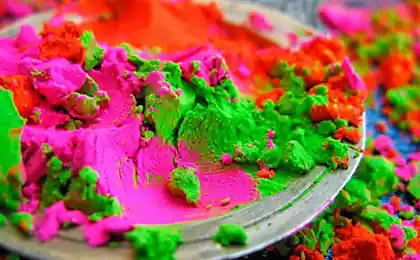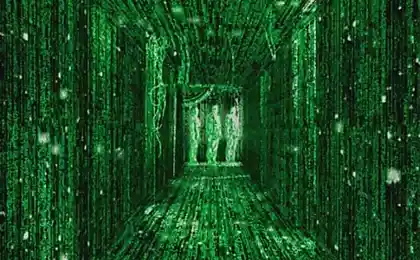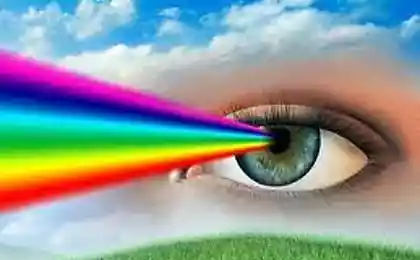694
Vinozito sea and brassy skies: how to change the perception of color in the languages of the world
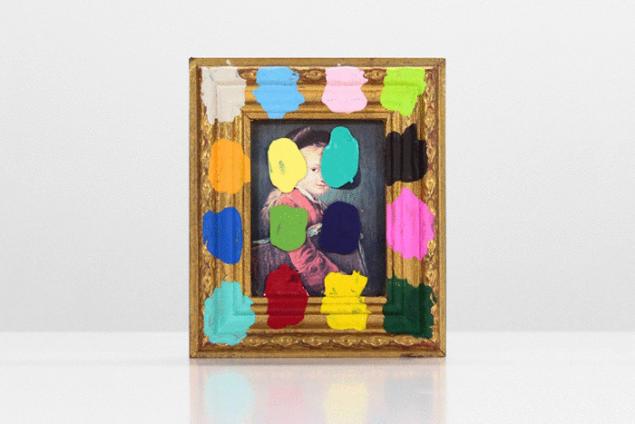
© Chad Wys
Why in the "Iliad" sea — purple, and the honey green? Israeli linguist guy Deutscher in his book "Through the mirror of language" showed how strange and varied might the world look like in different languages. "Theory and practice" translated excerpt from the book is about how observation of the British politician William Gladstone aroused the interest of scientists to the perception of color and why blue recently was a shade of black.
No one will deny that between the times of Homer and modernity lies a wide gap over the millennia that separate us, were built and empires fell, appeared and disappeared of religion and ideology, and science and technology have extended our intellectual horizons and changed almost all aspects of our daily lives. But if this huge choppy sea it was possible to provide only one Bastion of constancy, one vital aspect that has remained since the times of Homer to the present day, it would be fun with bright colors of nature: blue sky and sea, crimson sunset, green foliage. If there is a phrase that embodies stability in the chaos of human experience, that phrase: "Daddy, why is the sky blue?"
Or not? The symptom of outstanding intellect — the ability to question the obvious, and the attention of Gladstone to the "Iliad" and "Odyssey" leaves no room for doubt that in the Homeric perception of color is something very wrong. The most striking example is how Homer describes the color of the sea. One of the most known expressions in his poems — "vinozito the sea." But let's consider this description with gladstonos pedantry. As it happens, "vinocity" — this is the interpretation of the translator, while Homer himself says is oinops, which literally means "like wine" (oinos is "wine" and op — "see"). But what is common in sea water with wine? In response to a simple question Gladstone scientists have proposed everything imaginable and unimaginable theories to wave away from this problem. The most common assumption is that Homer was referring to deep purplish-red tint, which happens in a troubled sea at sunset and dawn. But there is no evidence that using this epithet, Homer was referring to the sunset or the dawn sea. Also it has been speculated that the sea sometimes becomes red due to a certain species of algae. Another scientist, in desperation, to think about how to portray the sea red, tried to make wine blue and claimed that "blue and purple reflections are visible in certain wines of southern regions, and especially vinegar, made from home-made wines".
Another point in the arguments of Gladstone — how remarkably colorless Homer's reverent verse. Flick through anthologies of modern poetry, and the color caught your eye. What self-respecting poet drew inspiration from "green fields and sky-blue"?No need to explain why all these theories are untenable. But there is another way to circumvent this difficulty, which has been used by many self-respecting commentators and needs separate consideration: poetic license. One eminent classicist, for example, ignored the arguments of Gladstone, saying: "If someone says that the poet was disturbed sense of color, because he described the sea by this vague word, I parry that criticism lacks a sense of poetry." But in the end, elegantly-vain the censure of critics could not win podstanovki literalism, because his analysis showed that poetic license can not explain all the weirdness in the color descriptions of Homer. Gladstone was not deaf to poetry, and he was well prepared to effect what he called "distorted color epithets". But he also knew that if these mismatch — only exercises in the art of poetry, the distortion should be the exception rather than the rule. In another case, such a result is not poetic license, and the error. And it shows that this promiscuity in colours were for Homer the rule, not the exception. To prove it, Gladstone outlined range of evidence and confirmed these points with examples, is described on 30 pages, of which I quote only a few.
First, consider what other objects Homer assigns the "wine" color. Apart from the sea, Homer calls the "vinocity" only... bulls. And none of the linguistic somersaults the critics could not refute the simple conclusion of Gladstone: "there is Not the slightest difficulty in the mapping of these objects on the basis of common colors. Sea blue, green, or blue. The bulls are black, he has Bay or brown".
And how do you explain the use of the name violet, which Homer uses as a designation of colour... the sea (the phrase ioeidea ponton transferred, depending on the inspiration of the translator as "dark violet sea", "purple ocean" or "purple deep"). And is it poetic license allows Homer to use the same flower to describe the sheep in the cave of the Cyclops as "beautiful and large, with thick violet wool"? Supposedly Homer was referring to black sheep, which is actually not black but dark brown. But "purple"? Or how about another place in the Iliad, when Homer uses the word "violet" to describe iron? And if the violet seas, violet sheep, and violet iron can be attributed to poetic license, like to be with another passage, when Homer compares Odysseus's dark hair with the color of the hyacinth?
The Homeric use of the word "chloros" is no less peculiar. In later versions of the Greek language chlôros means "green". But Homer uses it in a number of cases that are not suitable to green. Most often, chlôros appears as a description of faces pale from fear. This may be a metaphor, but chlôros is also used to describe fresh bars and clubs of the Cyclops, made of olive wood. And twigs, and the tree we now would call gray or brown. Here Homer wins from our doubts. But the magnanimity of the readers comes to an end when the poet uses the same word to describe honey. Who saw green med — raise your hands.

Another point in the arguments of Gladstone — how remarkably colorless Homer's reverent verse. Flick through anthologies of modern poetry, and the color caught your eye. What self-respecting poet drew inspiration from "green fields and sky-blue"? Whose poetry sang of the time of year,"when Narcissus, when bindweed, fialochka, and wild onions, and snapdragons, and yellow gorse and buttercups cover the meadow"? Goethe wrote that no one can remain insensitive to the most alluring colors of nature.
But as it turned out, no one except Homer. Take his description of the horses. Gladstone explains: "Color is such an important thing in the horses that she's just forcing herself to describe. But though Homer so loved the horse that wasn't tired to put a lot of heart in their poetic description, in his living and beautiful color images are given so little space". Homer's silence about the sky cries out even louder. "Homer was dealing with the most beautiful specimen of blue. But he never describes heaven this word. It is starry, or broad, or great, or iron, or copper, but never blue."
The contemporaries of Homer saw the world mostly in the contrasts between light and dark, and the colors of the rainbow is perceived as uncertain tones between white and black. Or, to be more accurate, they saw the world in black and white interspersed with red, as Gladstone concluded that the sense of color began to develop in the time of Homer, and primarily consisted of red Donaldson calculated that Homer used the adjective melas (black) about 170 times. The words meaning "white" appear around 100 times. In contrast with this abundance, the word eruthros (red) appears 13 times, xanthos (yellow) — almost a dozen times, ioeis (violet) six times, and other colors even less.
In the end Gladstone discovers that even the simplest colors of the spectrum do not appear in the text. Most striking is the absence of the word describing the color blue. The word kuaneos, which in later stages of development of the Greek language, meant "blue" appears in the text, but, rather, for Homer it simply means "dark" because he uses it not to describe the sky and the sea, and to describe the eyebrows of Zeus, the hair of Hector, or a dark cloud. Green is also rarely mentioned, since the word chlôros is mainly used for non-green things and at the same time, in the text there is no other word that supposedly meant the most common of colors. And in Homer's color palette not seen any equivalents of orange or pink.
According to legend, Homer, like any bard, was blind. But Gladstone quickly rejects this version. In all that is not for the color, Homer's descriptions are so vivid and alive that they could make people who had never seen the beauty of the world. What is more, Gladstone proves that the oddities in the Iliad and Odyssey could not be associated with any personal problems Homer. Let's start with the fact that if the status of Homer was the exception to his contemporaries, his defective descriptions cut to the hearing and would be adjusted. In addition, the traces of these oddities appeared in the texts of ancient Greece and for centuries later. The phrase "violet hair color", for example, was used in the poems of Pindar in the fifth century before Christ. Gladstone shows on actual examples that the color descriptions of later Greek authors, even not being so incomplete, like Homer's, "continued to be pale and indefinite in extent, surprising for the modern man". So, whatever was "wrong" with Homer, that influenced his contemporaries and subsequent generations. How to explain it?
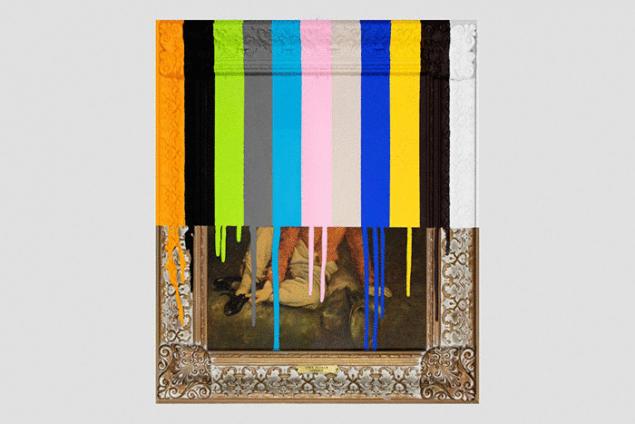
Gladstone the answer to this question was so strange and radical idea that he himself seriously doubted whether he should include it in the book. That makes the assumption even more stunning is the fact that he had never heard about color blindness. Although, as we shall see, this condition soon became known in 1858 color blindness was unknown to the General public, and even those few scholars who knew about the phenomenon, could hardly understand him. Nevertheless, without using the term itself, Gladstone suggested that color blindness was widespread among the ancient Greeks.
The ability to distinguish colors, as he assumed a fully developed relatively recently. The contemporaries of Homer saw the world mostly in the contrasts between light and dark, and the colors of the rainbow is perceived as uncertain tones between white and black. Or, to be more accurate, they saw the world in black and white interspersed with red, as Gladstone concluded that the sense of color began to develop in the time of Homer, and primarily consisted of red tones. This conclusion can be drawn from the fact that a limited color supply of Homer greatly expanded at the expense of red and the word for red — eruthros, unusual for the poet used in the descriptions of items is really red — like blood, wine, and copper.
Undeveloped color perception, Gladstone argues, can immediately explain why Homer so vividly and poetically describes light and dark and so silent in relation to the colors of the rainbow. Moreover, strange epithets of Homer just "fall into place, and we understand that from his point of view, the poet used them skillfully and effectively". If you interpret the Homeric epithets "purple" and "vinocity" as describing not certain shades and degrees of darkness, then terms like "violet sheep" or "vinozito sea" no longer seem strange.
Geiger went on Gladstone in one important aspect. He first posed the fundamental question around which the dispute subsequently broke out between nature and culture: the relationship between what the eye can see, and the fact that the language is capable of operationare Lazarus Geiger to the language of color grew out of studies of Gladstone. While most of his contemporaries turned their glances away from podstanovki statements about the immaturity of the color perception of Homer, his work has inspired Geiger for the study of the descriptions of color in other ancient cultures. Scientist has discovered an incredible coincidence weirdo Homer. For example, Geiger describes the old Indian poems and their relationship to the sky: "These hymns, consisting of more than 10,000 rows, filled with descriptions of heaven. Hardly any other object is mentioned so often. The sun and the play of color at dawn, day and night, cloud and lightning, air and space unfold before us again and again, in bright and shiny fullness. But there's only one thing that cannot be learn from these ancient songs, if you didn't know her before, is that the sky is blue".
So not only Homer didn't notice the blue color, but the ancient Indian poets too. As it turned out, and Moses, or at least whoever wrote the old Testament. It is no secret, says Geiger, that the heavens play a significant role in the Bible, appearing in the very first verse — "In the beginning God created the heaven and the earth" and in hundreds of other places. And, like the Greeks of the Homeric times, the biblical Jew did not know the word "blue". Other color descriptions in the old Testament is very similar to the Homeric. No matter what the circumstances nor caused inaccuracies in the descriptions of Homer, the authors of the Vedas and of the Bible lived in the same conditions. In fact, all of humanity existed in these conditions for a thousand years, since the Icelandic sagas and even the Koran present the same features of color perception.
But then Geiger is only just beginning to accelerate. Podstanovki expanding the circle of evidence, he plunges into the murky depths of etymology. He shows that the words for the color blue in modern European languages come from two sources: to a lesser extent from words that earlier meant green, and to a greater extent — from the words, the first signifying black. The same mixture of black and blue found in the etymology of the word "blue" in completely different languages — for example, in Chinese. The result is the assumption that in the early period of the history of all these languages, "blue" was not yet recognized as an independent concept.

Geiger has revolutionized the complete chronological sequence in which there was a sensitivity to different colours of the spectrum. At first I had a sensitivity to red, then to yellow, to green and finally to blue and violet. What is most remarkable, said the scientist, — the development seems to have occurred in the same sequence in different cultures around the world.
Geiger went on Gladstone in one important aspect. He first posed the fundamental question around which the dispute subsequently broke out between nature and culture: the relationship between what the eye can see and what language can describe.
In 1869, two years after Geiger has found significant Parallels between the color vocabularies of different ancient cultures, the newly established German journal of Ethnology published a short note by Adolf Bastian, an anthropologist and the bestselling author of travels. Bastian argued that oddities of color perception not limited to the ancient era and there are still Nations that draw the line between blue and green not as Europeans. His servant in Burma, the anthropologist wrote, "apologized once that he couldn't find a bottle that I called blue ("ROI"), because it actually was green ("sehn"). To punish him, holding up to ridicule, I shamed him in front of other servants, but quickly realized that I have become a laughingstock of myself." Bastian also argued that tagali in the Philippines did not distinguish between green and blue before colonization by the Spaniards, because the Tagalog words for blue and green was borrowed from the Spanish language. And added that the language of the tribe Ted in Chad, this distinction is not so far.
Data obtained during studies of view of the natives, contrary to the hypothesis that defective vocabulary reflected defective color vision, since none of the discovered tribes failed the test according to the discernment of swetow 1869 nobody gave much importance to the stories of Bastian. But after the debate around the theory of Magnus, and cultural studies understand the importance of that information and decided that you need to collect more data about the tribes living in remote corners of the Earth. The first such study was done in 1878 by Dr. Ernst Almquist, who was on Board a Swedish expedition ship stuck in polar ice. As the ship had to winter on the Chukchi Peninsula in Eastern Siberia, Almquist used this opportunity to test the perception of the Chukchi. Americans such studies were easier, because a lot of savages lived right under their noses. Military doctors were ordered to test the perception of the Indian tribes, and their evidence ethnologist albert Gatchet has made a detailed report. In Britain, the science writer Grant Allen devised questionnaires to send them missionaries and researchers, and to obtain data on the perception of the peoples they encountered. And finally, faced with a direct challenge to his own claims, Magnus himself decided to conduct its own investigation and sent questionnaires to the color tables of hundreds of consuls, missionaries, and doctors all over the world.
When they began to appear the results, they are in some sense maximally eloquently confirmed the insight of Gladstone and Geiger. In America albert Gatchet wrote that Indian tribes in Oregon were content with one term for "the color of grass, seeds or plants, and although the color of the plants changed from green to yellow depending on the season, the name of the color has not changed". The Sioux Indians of Dakota also used one word for blue and green. Such confusion was common in other Indian languages.
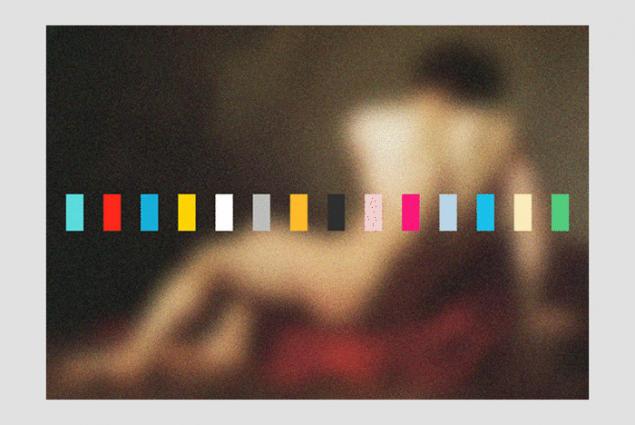
Were found with other languages that correspond to intermediate stages of development predicted by Geiger: the inhabitants of the island of Nias in Sumatra, for example, used only four basic words for colors: black, white, red and yellow. Green, blue and violet were called "black". And some languages had words for black, white, red, yellow and green colors, but no blue.
Data obtained during studies of view of the natives, contrary to the hypothesis that defective vocabulary reflected defective color vision, since none of the discovered tribes failed the test for distinguishing colors. Virchow, and members of the Berlin anthropological community conducted a color test Holgrem among the Nubians and asked them to choose their pile of balls of wool a ball of the color that corresponded to shown them the ball. None of them made a mistake. The same picture was and in other ethnic groups. Some researchers reported that certain tribes have a big problem with the distinction between cold colors than red and yellow. But none of them was blind to these color differences. Missionary, lived with the tribe, ovaherero in Namibia, wrote that Africans see the difference between green and blue, but just think that it would be foolish to give separate names to the shades of the same color. What seemed impossible a few years ago has become fact: people can distinguish between colors and not to give them different names.published
Source: theoryandpractice.ru
Can the Tesla Model S P85D to outdo the Ferrari F12berlinetta?
What to do to sleep only a few hours a day at a convenient time







